Concave mirror: characteristics, examples, applications
We explain Concave mirror with characteristics, examples and applications. The concave or convergent mirror is a mirror with almost always spherical shape, in which the reflecting surface is on the inner side of the sphere or rather a part of it. Other curved shapes are also possible, such as the parabola. example of a concave mirror
With curved mirrors, like the concave mirror, it is possible to achieve various images: enlarged, diminished or even inverted. Magnified images make it easier to see the fine details of an object.
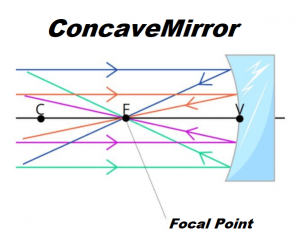
In a concave mirror, the magnification is achieved because the curvature allows the light to be focused in much the same way as a lens does. example of a concave mirror
The mirror works as shown in the figure above. Horizontal rays incident light coming from the left, where there is a distant source such as the sun . These rays comply with the law of reflection, which states that the angle of incidence of the light ray is equal to its angle of reflection.
After being reflected, the rays intersect at a special point, the F point or focal point , because that is where the light is focused. By placing objects at different locations on the axis through C, F, and V, the various images are obtained.
For example, between the focal point and the vertex of the mirror is the ideal place to place the face when applying makeup or shaving, because in this way an image with great detail is achieved that is not possible with a flat mirror.
Characteristics of a concave mirror
Before seeing how the image is formed, we carefully analyze the points and distances presented in this illustration:
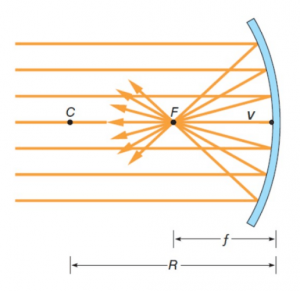
-The center of the sphere to which the mirror belongs is at point C and R is its radius. Point C is known as the center of curvature and R is the radius of curvature. example of a concave mirror
The point V is the vertex of the mirror.
-The line that joins points C, F and V is known as the optical axis of the mirror and is perpendicular to its surface. A ray that falls through these points is reflected in the same direction and in the opposite direction.
-The reflection of incident rays parallel to the optical axis intersect at point F, called the focal point of the mirror.
-Note that point F is approximately halfway between C and V.
-The distance between F and V, denoted as f , is called the focal length and is calculated as: example of a concave mirror
f = R / 2
Graphical method
As said before, depending on the point where the object is placed, various images are obtained, which are easily visualized through the graphic method for mirrors.
This method consists of drawing rays of light coming from strategic points of the object and observing how they are reflected in the specular surface. The image is obtained by prolonging these reflections and looking at where they intersect.
In this way it is known if the image is bigger or smaller, real or virtual – if it is formed behind the mirror – and right or inverted.
Examples of concave mirrors
Let’s see some examples of images obtained using concave mirrors:
Object between F and V
Placing the object between points F and V we can obtain an amplified virtual image. To visualize it, three main rays are drawn, as shown in the illustration below:
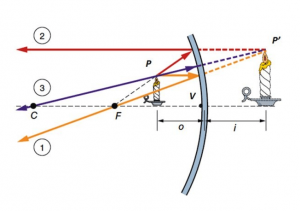
-Ray 1, which leaves the flame at point P, is parallel to the optical axis and is reflected through F.
-Ray 2: it strikes in such a way that it is reflected in a direction parallel to the optical axis. example of a concave mirror
-Finally ray 3, which is radial, arrives perpendicular to the mirror and is reflected in the opposite direction, passing through C.
Note that the law of reflection is fulfilled the same as in the flat mirror, with the difference that the normal to the surface of the curved mirror changes continuously.
Actually, two rays are enough to locate the image. In this case, by prolonging the three rays, they all intersect at a point P ‘behind the mirror, which is where the image is formed. This image is virtual – in reality it is not crossed by any luminous ray -, it is upright and it is also larger than the original.
Object between C and F
When the object is between the focal point and the center of curvature of the mirror, the image that is formed is real – it is not located behind the mirror, but in front of it – it is magnified and inverted.
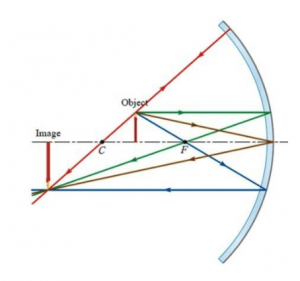
Object beyond the center
The illustration below shows the image formed by an object far from the center of the mirror. The image is formed in this case between the focal point F and the center of curvature C. It is a real image, inverted and smaller than the object itself.
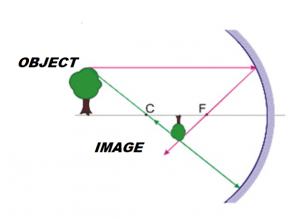
Side magnification
We can ask ourselves how amplified or diminished is the image obtained by means of the concave mirror, for this the lateral magnification is defined , denoted as m . It is given by the quotient between the size of the image and the size of the object: example of a concave mirror
m = image size / object size
The image formed by a mirror can be smaller than the size of the object, still, m still called magnification or increase side.
Concave mirror applications
The property of concave mirrors to magnify images is used in important applications ranging from grooming to obtaining clean energy.
Magnifying mirrors

They are commonly used in the boudoir for grooming purposes: putting on makeup, shaving, and tying a tie.
Reflection Optical Telescope
The first reflecting telescope was created by Isaac Newton and uses a concave mirror plus a lens as an eyepiece. One of the Cassegrain-type telescope mirrors is concave and parabolic and is used to collect light at the focal point.
Dental mirrors
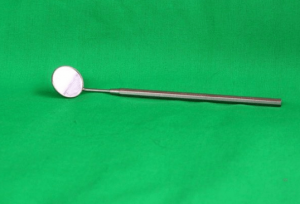
Dentists also use concave mirrors to obtain a magnified image of the teeth, so that the teeth and gums can be examined in as much detail as possible.
Car headlights example of a concave mirror
In car headlights, the bulb filament is placed at the focal point of a concave mirror. The light rays originating from the filament are reflected in a parallel ray beam.
The mirror is often spherical, but sometimes the parabolic shape is used, which has the advantage of reflecting in a parallel beam all the rays coming from the focal point and not just those near the optical axis. example of a concave mirror
Solar concentrators example of a concave mirror
Light from a distant source like the Sun can be focused on a point by the concave mirror. Thanks to this, the heat is concentrated at that point. On a large scale, with this heat a fluid can be heated, such as water or oil for example.
This is concentrated solar thermal energy that tries to produce electrical energy by activating a turbine propelled by the concentrated heat of the Sun at one point. It is an alternative procedure to the semiconductor photovoltaic cell.